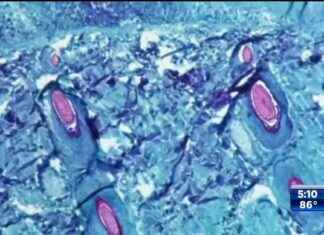A 99 million year old juvenile dinosaur fell into a trap and lost a piece of its tail.
The loss of that dinosaur was paleontology’s gain. The truncated tail is still visible millions of years later in an amber chunk, with its feathers and some remnants of preserved soft tissue.
The remarkable specimen was described by researchers in a new study. It is the first amber evidence from an extinct nonavian theropod. This means that it wasn’t a lineage that gave rise to modern birds. This remarkable preservation offers a glimpse into dinosaur biology that cannot be found in fossil records. It also provides rare insight into feather structures in extinct dinosaurs which could aid scientists in better understanding how feathers evolved. [Photos by Amber Trap Nabs Feathered dinosaur Tail]
The study authors stated that there is increasing evidence pointing to the existence of non-avian dinosaur feathers. However, these feathers only provide a partial picture. Fossilized feathers can be difficult to reconstruct in 3D because they are often compressed and distorted. They often appear in the geologic records without any skeletal fossils around, making it difficult for scientists to identify their species.
Amber is able to preserve 3D structures well. The study describes a tail fragment measuring approximately 1.4 inches in length. It is densely covered by feathers that are reddish-brown on the upper surface, and paler and finer beneath.
Computed tomography scans (CT) further revealed soft tissue — skin, ligaments, and muscles. Most of these tissues were replaced by carbon. The tail contained at least eight complete vertebrae. However, the authors pointed out that it was only a small portion of a longer tail, which could have as many as 25 vertebrae. However, its overall size suggests that the dinosaur wasn’t fully grown.
The tailbone structure — a string rather than a fusedrod — suggested that the tail’s feathery former owners was a nonavian dinosaur. This coelurosaur, a type of theropod that shares many characteristics with birds, is likely to have been the tail of a coelurosaur.
Fossil feathers had a branching structure that produced large and small filaments. However, they did not have a central shaft called a “rachis” which is an evolutionary feature in modern feathers. The study authors concluded that this suggests that feather branching evolved first.
This amazing find demonstrates the special role amber plays in helping scientists interpret how animals looked millions of years ago and how evolution shaped extinct animals.
“Amber pieces preserve tiny snapshots in ancient ecosystems but they record microscopic detail, three-dimensional arrangement and labile tissue that are difficult to study elsewhere,” Ryan McKellar, study co-author, who is a curator of invertebrate paleontology at Canada’s Royal Saskatchewan Museum, stated in a statement.
McKellar stated, “This is an important source of new information that is worth investigating with intensity and protecting it as a fossil resource.”
These findings were published online in Current Biology on December 8, 2008.
Original article at Live Science







